Robotic Lawn Mower Market Size
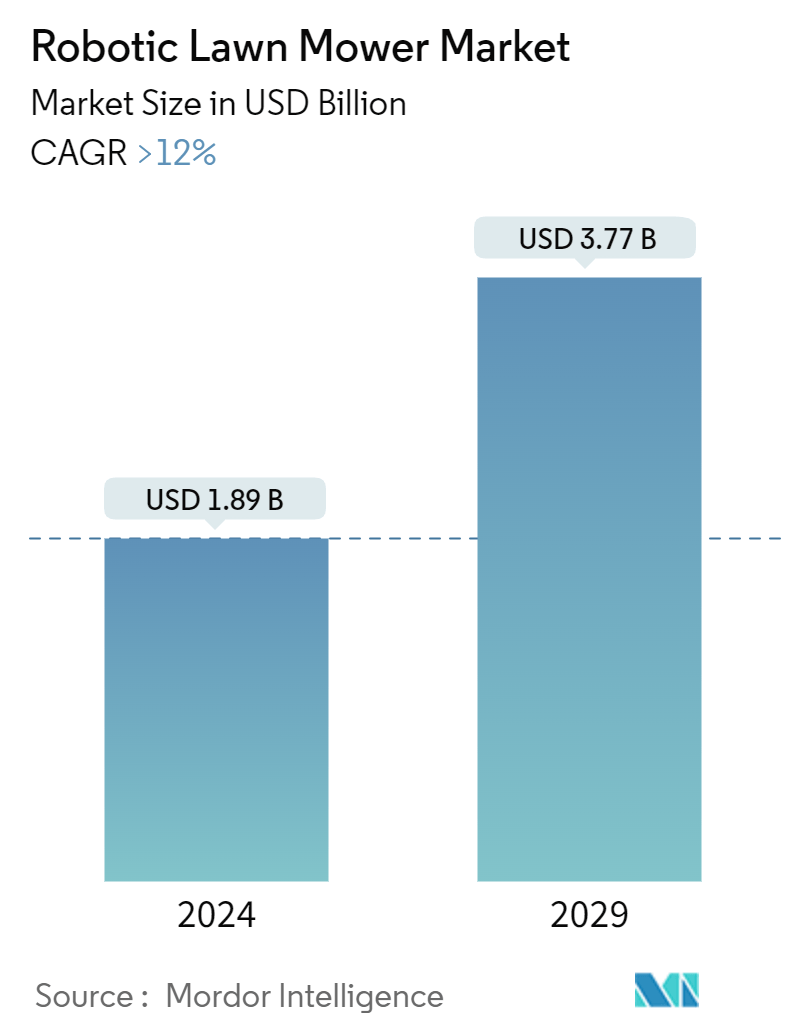
| Study Period | 2019 - 2029 |
| Market Size (2024) | USD 1.89 Billion |
| Market Size (2029) | USD 3.77 Billion |
| CAGR (2024 - 2029) | > 12.00 % |
| Fastest Growing Market | Europe |
| Largest Market | Europe |
Major Players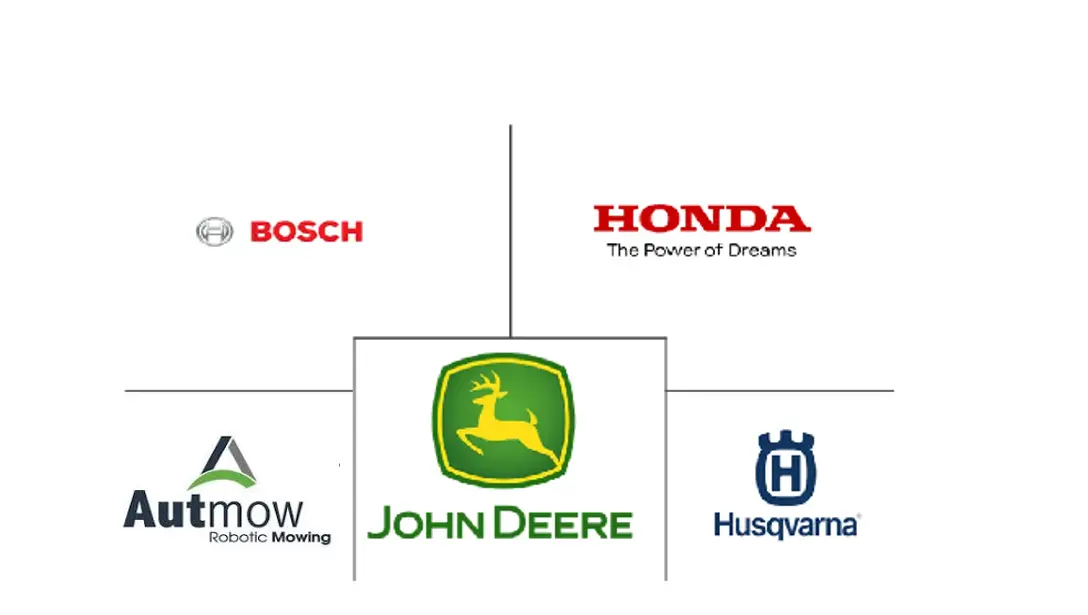
*Disclaimer: Major Players sorted in no particular order |
Need a report that reflects how COVID-19 has impacted this market and its growth?
Robotic Lawn Mower Market Analysis
The Robotic Lawn Mower Market size is estimated at USD 1.89 billion in 2024, and is expected to reach USD 3.77 billion by 2029, growing at a CAGR of greater than 12% during the forecast period (2024-2029).
Technological advancements in artificial intelligence and robotics have created more efficient household appliances and reduced human intervention. With an increase in the income level of people living worldwide, there is an increase in sales of these appliances that enhance the aesthetics and user experience. Features like low-noise operation, sensors, self-charging, and durability are expected to drive the market growth.
However, the high installation cost required for the initial setup of a robotic lawn mower is expected to limit the growth of the target market.
Europe is expected to hold a significant share of the global market and grow rapidly due to the region's high demand for professional lawn mowers, landscaping devices, and automated tools. Furthermore, the shift of customers away from traditional gasoline-powered manual lawn mowers and toward newer, silent, efficient, smart, and battery-powered robotic mowers is broadening Europe's growth prospects.
The usage of autonomous machines in household applications such as cleaning and cutting grass has witnessed a significant increase, which is also expected to boost the market growth during the forecast period. The inclusion of technologies, such as the Internet of Things (IoT) and machine learning (ML), are also facilitating market growth. These technologies help lawn mowers sense obstacles, and the sensors work on acceleration and orientation to improve performance and provide better results. For instance, Bosch uses both AI and ML in its lawn mowers for obstacle identification.
Robotic Lawn Mower Market Trends
The Residential Segment is Expected to be the Largest Segment by End User
The fast and busy lifestyle of people across the world due to urbanization has increased the demand for autonomous machinery/systems to help people in everyday work. Additionally, increased spending on backyard beautification, backyard cookouts, and garden parties, as well as the desire to save time spent on lawn maintenance activities, are driving demand for a variety of gardening tools, which is driving the target market.
The market is also influenced by the expanding construction and tourism industries around the globe. Furthermore, shifting consumer preference for efficient lawn mowers and the growing popularity of autonomous equipment requiring minimal user intervention is expected to boost global demand for robotic lawn mowers.
Major players are investing heavily in research and development to enhance the features of robotic lawn mowers. Key players are integrating ledge sensors and additional features such as laser vision, lawn mapping, smart navigation, and self-emptying into their products to improve their performance and efficiency. The market is expected to benefit from the increased availability of more efficient robotic lawn mowers in the near future. For instance,
- In May 2022, Toro announced the launch of a battery-powered residential yard care category robotic mower. It is the industry’s first vision-based localization system with wire-free navigation, making this setup manageable. It is tailored to each yard without a pricey and failure-prone underground boundary wire installation. The company also offers a dedicated smartphone application that helps users customize their mowing schedule.
Furthermore, recent advances in the development of lithium-ion batteries and robot technology are undoubtedly responsible for this increase in the sales of robotic mowers.
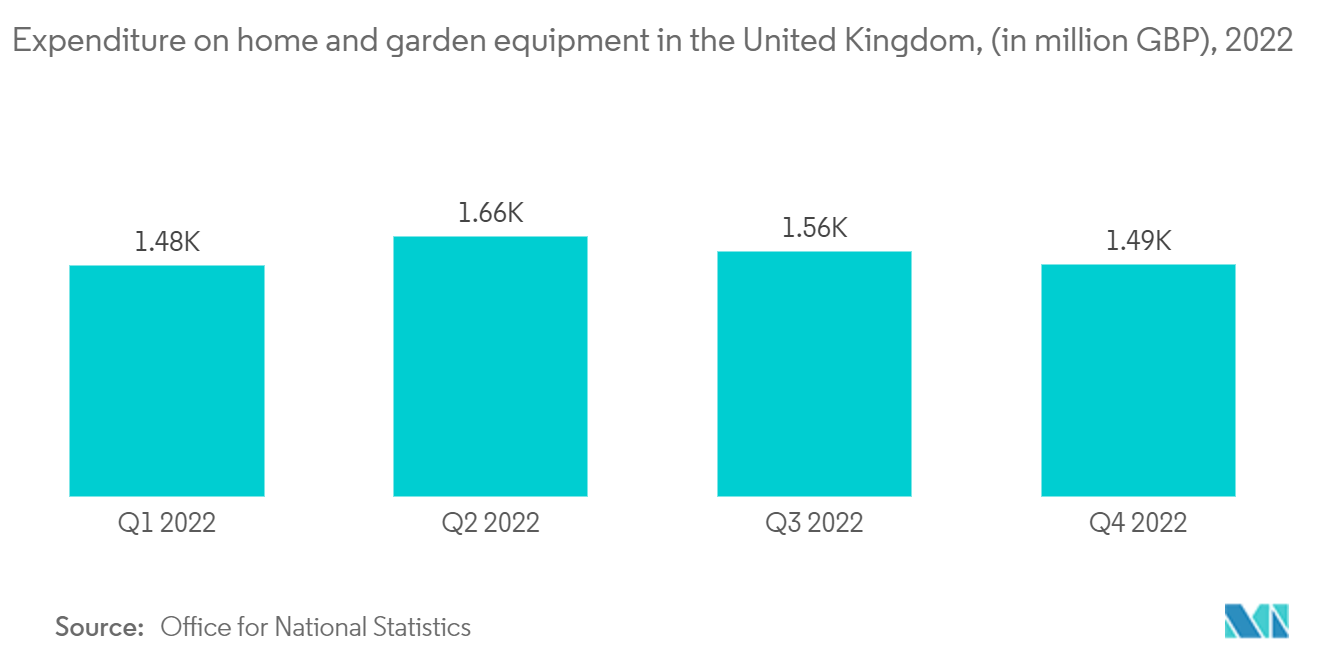
Europe is Expected to be the Market Leader
Robotic lawn mowers are used for various gardening and lawn-maintenance applications in Europe's residential and commercial sectors.
One of the major factors driving growth in the region is the popularity of lawns to provide aesthetic and pleasing premises and gardens. The increased adoption of robotic lawn mowers in countries like the United Kingdom and the Netherlands is expected to drive market growth.
Furthermore, many Europeans own independent residential spaces, typically private lawns and gardens, boosting demand for robotic lawn mowers. Aside from that, the rising demand for automation in the commercial sector and increased awareness of the benefits of robotic lawn mowers, such as noise-free operations, time management, and energy conservation, have boosted the market growth in the region. The inclusion of smart sensory controls in robotic lawn mowers, which enable automated mowing of a given landscape, is expected to impact market demand during the forecast period.
Key players in Europe are adopting new technologies to provide quality products to their customers. The rise in promotional activities is also expected to have a positive impact on the market in the region. For instance,
- In June 2022, Segway announced that its Navimow robot lawn mower would be available in 12 European countries by the end of May. The countries on this list include the United Kingdom, Netherlands, Italy, and Sweden. Navimow is available in three models, with the largest able to mow an area up to 3,000 m² (32,392 ft²) between charges.
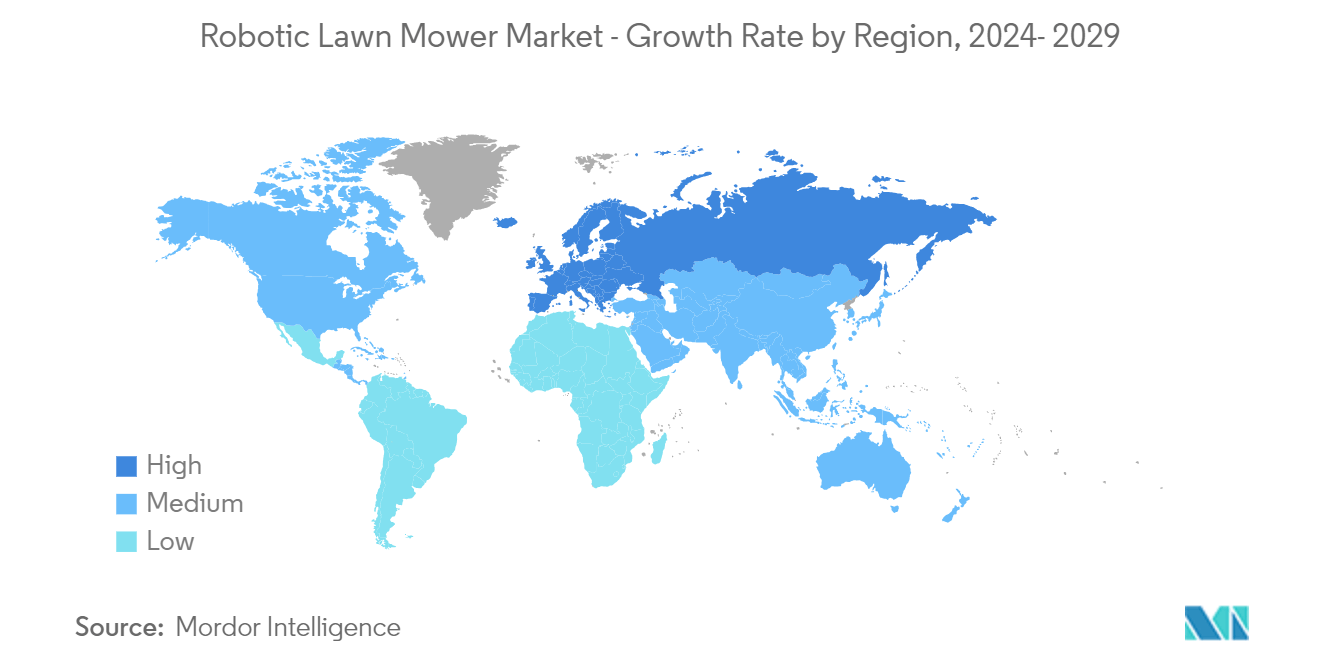
Robotic Lawn Mower Industry Overview
The robotic lawn mower market is fragmented, with several players competing for a considerable share of the market. Some of the prominent companies in the robotic lawn mower market include John Deere, Robert Bosch, Honda, and Husqvarna. The companies spend heavily on R&D to innovate and develop new and technologically advanced products.
Robotic Lawn Mower Market Leaders
John Deere
Robert Bosch
Honda Motor Company
Husqvarna Group
Autmow Robotic Mowing
*Disclaimer: Major Players sorted in no particular order
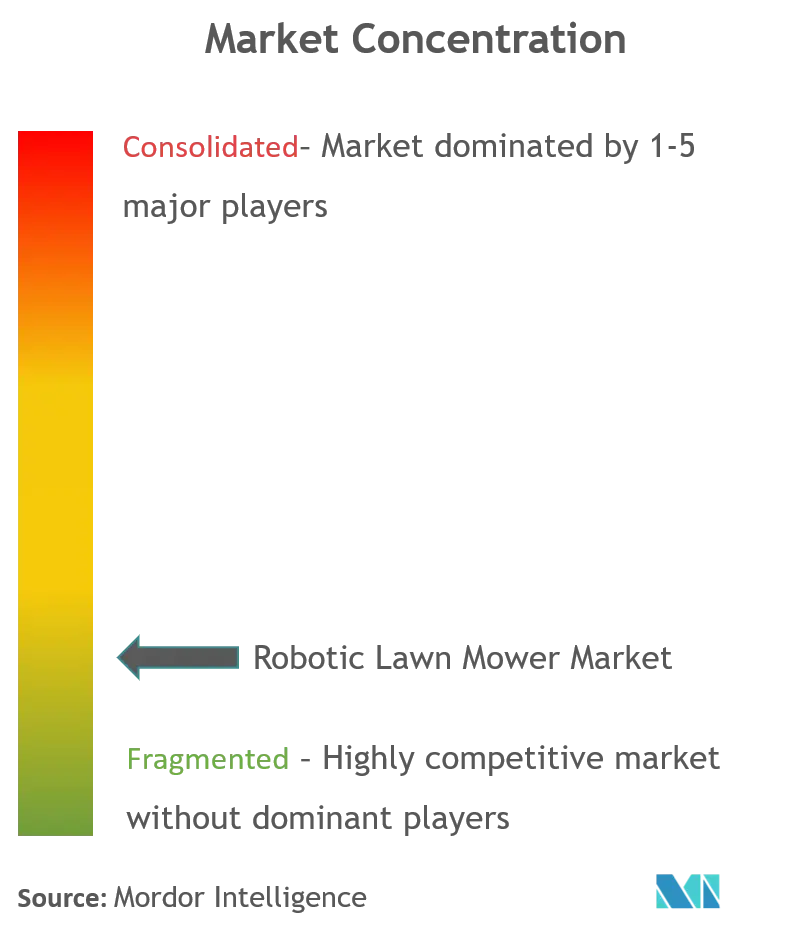
Robotic Lawn Mower Market News
- March 2024: Segway announced the official release of its highly anticipated Navimow i Series robotic lawn mower. Segway Navimow offers two models, namely, i105 and i110. i105 covers 1/8 acre and i110 covers 1/4 acre. The two variants will be priced at USD 999 and USD 1,299, respectively, marking one of the most accessible wire-free robotic lawn mowers in the market.
- August 2023: Dreametech Technology announced the launch of its new product line, the Robotic Mower. The Dreame Roboticmower A1 incorporates a 3D lidar solution. With a focus on the mid-to-high-end market, these products are expected to debut in the European and North American markets early next year. Dreame Roboticmower A1 incorporates Dreame Technology's patented technologies, including mapping, path planning, positioning, obstacle avoidance, and other industry-leading intelligent algorithm technologies.
Robotic Lawn Mower Market Report - Table of Contents
1. INTRODUCTION
1.1 Study Assumptions
1.2 Scope of the Study
2. RESEARCH METHODOLOGY
3. EXECUTIVE SUMMARY
4. MARKET DYNAMICS
4.1 Market Drivers
4.1.1 Rising Residential Activities in Addition to Consumer Spending to Enhance Market Demand
4.2 Market Restraints
4.2.1 Rising Electric Vehicle Adoption to Hinder Market Growth in the Long Run
4.3 Industry Attractiveness - Porter's Five Forces Analysis
4.3.1 Threat of New Entrants
4.3.2 Bargaining Power of Buyers/Consumers
4.3.3 Bargaining Power of Suppliers
4.3.4 Threat of Substitute Products
4.3.5 Intensity of Competitive Rivalry
5. MARKET SEGMENTATION
5.1 Range
5.1.1 Low
5.1.2 Medium
5.1.3 High
5.2 End User
5.2.1 Commercial
5.2.2 Residential
5.3 Geography
5.3.1 North America
5.3.1.1 United States
5.3.1.2 Canada
5.3.1.3 Rest of North America
5.3.2 Europe
5.3.2.1 Germany
5.3.2.2 Italy
5.3.2.3 Spain
5.3.2.4 Rest of Europe
5.3.3 Asia-Pacific
5.3.3.1 India
5.3.3.2 China
5.3.3.3 Japan
5.3.3.4 South Korea
5.3.3.5 Rest of Asia-Pacific
5.3.4 Rest of the World
5.3.4.1 South America
5.3.4.2 Middle East and Africa
6. COMPETITIVE LANDSCAPE
6.1 Vendor Market Share
6.2 Company Profiles
6.2.1 Deere & Company
6.2.2 Honda Motor Company
6.2.3 Autmow Robotic Mowing
6.2.4 Husqvarna AB
6.2.5 ANDREAS STIHL AG & Co. KG
6.2.6 WORX (Positec Tool Corporation)
6.2.7 Ambrogio Robot
6.2.8 The Toro Company
6.2.9 Mammotion
6.2.10 MTD Products Inc.
6.2.11 Robert Bosch GmBH
- *List Not Exhaustive
7. MARKET OPPORTUNITIES AND FUTURE TRENDS
7.1 Technological Advancements
Robotic Lawn Mower Industry Segmentation
A robotic lawn mower is an autonomous machine that operates autonomously within a defined area. The system is designed to include a mobile base, a docking station, a sensory feedback control programmed to mow the ground, and other accessories that aid in the system's operation. The inclusion of innovative features in a robotic lawn mower is expected to assist key vendors in attracting more customers and increasing their market share.
The robotic lawn mower market is segmented by range, end user, and geography. By range, the market is segmented into low range, medium range, and high range. By end user, the market is segmented into commercial and residential. By geography, the market is segmented into North America, Europe, Asia-Pacific, and the Rest of the World. The report covers the market size and forecast in terms of value (USD) for all the above segments.
| Range | |
| Low | |
| Medium | |
| High |
| End User | |
| Commercial | |
| Residential |
| Geography | |||||||
| |||||||
| |||||||
| |||||||
|
Robotic Lawn Mower Market Research FAQs
How big is the Robotic Lawn Mower Market?
The Robotic Lawn Mower Market size is expected to reach USD 1.89 billion in 2024 and grow at a CAGR of greater than 12% to reach USD 3.77 billion by 2029.
What is the current Robotic Lawn Mower Market size?
In 2024, the Robotic Lawn Mower Market size is expected to reach USD 1.89 billion.
Who are the key players in Robotic Lawn Mower Market?
John Deere, Robert Bosch, Honda Motor Company, Husqvarna Group and Autmow Robotic Mowing are the major companies operating in the Robotic Lawn Mower Market.
Which is the fastest growing region in Robotic Lawn Mower Market?
Europe is estimated to grow at the highest CAGR over the forecast period (2024-2029).
Which region has the biggest share in Robotic Lawn Mower Market?
In 2024, the Europe accounts for the largest market share in Robotic Lawn Mower Market.
What years does this Robotic Lawn Mower Market cover, and what was the market size in 2023?
In 2023, the Robotic Lawn Mower Market size was estimated at USD 1.66 billion. The report covers the Robotic Lawn Mower Market historical market size for years: 2019, 2020, 2021, 2022 and 2023. The report also forecasts the Robotic Lawn Mower Market size for years: 2024, 2025, 2026, 2027, 2028 and 2029.
What are the key considerations for businesses entering the Robotic Lawn Mower Market?
The key considerations for businesses entering the Robotic Lawn Mower Market are a) Brand positioning b) Pricing strategies c) Building a strong distribution network
Robotic Lawn Mower Industry Report
The global market for robotic lawn mowers is on the rise, fueled by an increase in gardening and lawn maintenance activities and technological advancements. These autonomous mowers, now featuring remote control and GPS, are gaining popularity in both residential and commercial sectors. The commercial robotic lawn mower segment, in particular, is expanding rapidly due to the demand for efficient, time-saving lawn care solutions. Market growth is also driven by higher spending on landscaping and a preference for smart, energy-efficient gardening tools. Despite the high initial costs, the integration of AI and IoT technologies is set to boost the market, making mowers more adaptable to various lawn types and sizes. Innovations focusing on battery life and features for both residential and commercial use are expected to spur further growth. According to Mordor Intelligence™ Industry Reports, the robotic lawn mower market is experiencing significant revenue growth, with detailed analysis and forecasts available in their free report PDF download.
